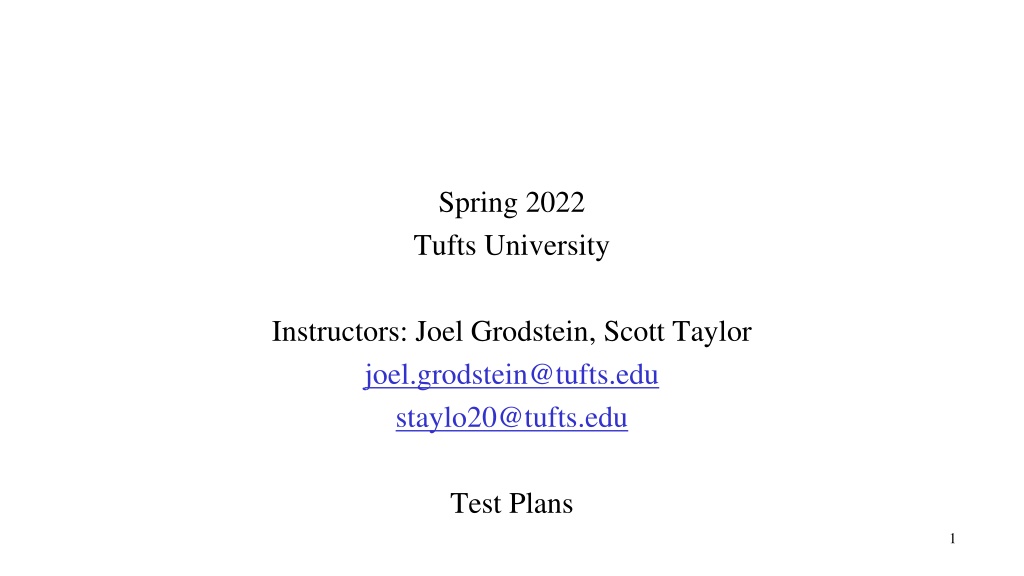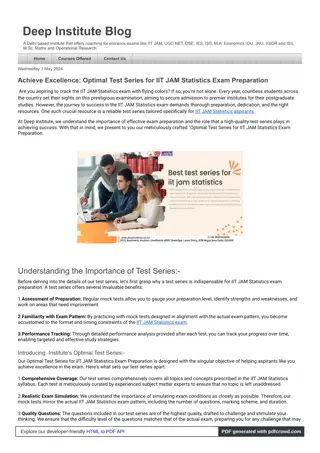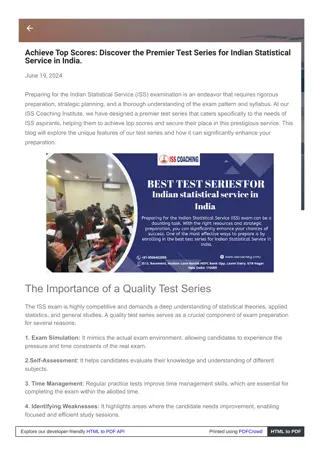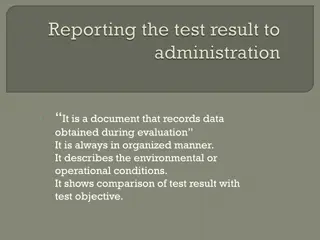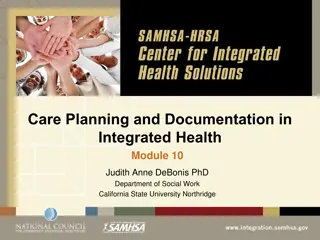Mastering Test Plans: Essential Guidelines for Success
Explore the crucial aspects of test plans in software development, including goals, granularity, parts, and real-world application. Understand why test plans are indispensable, how to define goals and non-goals, and key terminology. Gain insights on creating comprehensive test plans to enhance design quality and ensure systematic verification.
Download Presentation

Please find below an Image/Link to download the presentation.
The content on the website is provided AS IS for your information and personal use only. It may not be sold, licensed, or shared on other websites without obtaining consent from the author. Download presentation by click this link. If you encounter any issues during the download, it is possible that the publisher has removed the file from their server.
E N D
Presentation Transcript
Spring 2022 Tufts University Instructors: Joel Grodstein, Scott Taylor joel.grodstein@tufts.edu staylo20@tufts.edu Test Plans 1
Whats in this lecture Goals of a Test Plan Granularity of a Test Plan Parts of a Test Plan Test Plans IRL Putting it all together 2
Why do we need Test Plans? Designs are too complicated to wing it . Verification is a systematic method for achieving confidence in the design quality. Emphasis on SYSTEMATIC! Careful analysis and planning, by itself, can find bugs By specifying EVERYTHING we intend to test, others can review the document and point out areas we have missed We need a complete list of tasks and activities so we can scope the effort and timeframe How many people do we need, and for how long? 3
Test Plan Goals Specify ALL the planned work for an area Environment, Testbench, Stimulus, Checking, Coverage, etc Divide into reasonably sized concrete tasks with effort analysis More on this later. This is very hard! Define what THIS plan is covering, and what OTHER plans are assumed/guaranteed to be covering No underlaps , and only sensible overlaps Define the staging order of task execution Track what parts are completed, and which aren t. 4
Test Plan NON-Goals A test plan is not The only measurement of doneness , or even the total work . There are other tools and analysis methods that complement this. A static document. The test plan will evolve over time as all parties better understand the design and its weaknesses Foolproof. A plan is only as good as the things you THINK about adding to it. If you didn t think about it, it s probably broken 5
Test Plan Terminology Test Plan A document that defines a set of tasks that verify all aspects of some portion of the design Task A specific action that has a deliverable, an effort, and a deadline. There are many other attributes of a task that can vary based on the type of task. Test A specific set of stimulus (with associated correctness checking) designed to accomplish a specific action/response in the design. 6
Whats in this lecture Goals of a Test Plan Granularity of a Test Plan Parts of a Test Plan Test Plans IRL Putting it all together 7
What does a test plan cover, anyway? There s not just ONE test plan for a chip! We divide the effort into several overlapping areas Unit-level plans Feature-level plans Integration-level plans 8
Unit Level Plans Usually covers a specific geographic area of the chip Functional unit granularity Integer unit Cache controller PCIE controller Shader unit Sometimes we overload or subdivide this to cover a specific environment for the unit RTL-level simulation plan Gate-level simulation plan Emulation plan Silicon plan These usually get executed in this order over time 9
Feature-level Plans Some features/flows can t be mapped to a single geographic location or design hierarchy because they span many/all units Security Error handling (RAS) Clocks Reset Memory Coherency 10
Feature-level Plans Some features require specialized plans that concentrate on the feature or flow rather than the underlying logic End-to-end checkers Ensure consistent handling of the feature/flow across units Feature-level plans often don t have their own testbench/environment 11
Feature-level Plans Feature-level plans will overlap with unit and integration plans! Difficult to determine/negotiate which tasks go into which plan Often, Feature-level plans are a Master plan that shows all the work related to a feature, and documents which plan will cover which piece Remember, we want to test things in the lowest level environment that we can! Feature Testplan: Task 1 (Core plan) Task 2 (Interrupt plan) Task 3 (covered in this plan) Task 4 (SOC plan) Core Testplan: Task 1 Interrupt Testplan: Task 2 SOC Testplan: Task 4 12
Integration-level Plans Test a feature in the lowest level of model that can be used Don t test instruction cache parity generator at the SOC level! Instead, use the smallest environment (like the execution core testbench) so you can maximize Controllability and Observability This makes your test plan easier to write/execute Focus only on the features that are UNIQUE to a higher level integration Interactions of units Wrapper logic that only exists above your unit level testbenches End-to-end checking that passes through multiple units 13
What about overlap? We have limited resources (That s management-speak for engineers) We can t afford to verify the same thing over and over in every testbench/integration level. If you ve completely verified something in a low level testbench, what s the benefit of testing it a second time at a higher level?? However, SOME overlap is desirable Confirms any assumptions that the lower level environment might have made We are paid to be paranoid! 14
Possible CPU Test Plan Granularity Units L3 Integer Unit Floating-pt Unit L2 Debug Controller Interrupt Handler Cache Cache CPU Core Integrations Cluster of cores Full CPU SOC CPU Cache/ mem intf Other SOC Stuff Coherency Master Features DFT DFD Clocks Reset Interrupts Coherency RAS Security 15
Whats in this lecture Goals of a Test Plan Granularity of a Test Plan Parts of a Test Plan Test Plans IRL Putting it all together 16
Organizing your Test Plan A single test plan can be very short for simple/small designs (a few pages), or extremely long for more complicated features (hundreds of pages) A recent CPU I worked on had 1700 total pages across all testplans, not including the rest of the SOC! Good organization is CRITICAL to defining and executing such plans! 17
Critical pieces of a testplan What are your REFERENCE DOCUMENTS? What are your ASSUMPTIONS? What s the overall STRATEGY? What TESTBENCHES/environments do you need? What unique STIMULUS do you need to create for each testbench? What s the CHECKING strategy? How do you measure doneness (COVERAGE)? For each of the above, what are the TASKS that have to be executed? 18
Reference Documents List the documents you read as part of understanding the design Include the specific VERSION of the document!! That way you know to review things when a newer version comes out. It might change your test plan! 19
Assumptions What work do you believe will be covered by others? YOU MUST CONFIRM THIS!!!! What design assumptions are you relying on? What external (to you) tools do you require? What are your dependencies? Who do you need stuff from, and who needs stuff from you? Can you deliver? 20
Strategy How do you plan to approach testing this area of the chip? This will usually involve discussion of testbench, stimulus, checking, coverage, tools, Formal Verif, Emulation, etc What is your rationale for deciding what testbenches will be used to cover specific tasks? 21
Testbenches What testbenches are required to test aspects of this piece of the design? Why? Does your testplan create additional requirements for that testbench What are your assumptions for testcase runtimes? (test length and cycles-per-second should both be considered) Discuss: Why is this important? Will some components be shared across multiple environments? Example: ECC generator/checker 22
Stimulus What stimulus can you re-use from prior/existing work? What new stimulus needs to be created from scratch for this project area? What dependencies do you have on other teams? (and vice versa) 23
Checking Can you share/reuse existing checkers? Extend/modify existing checkers? Create entirely new checkers? What kind of checkers will you write? Reference models, self-checking code, scoreboards, etc. Will checks happen during the test, or at the end, or as a post- processing step? 24
Coverage How much coverage is required? Focused/hard-coded self-checking tests might not need much Purely random tests might need a lot What kinds of coverage are needed? RTL code coverage? Verification code coverage? Functional coverage? Visual Inspection? (this is manual eyeball review of simulation results, or just reading the code) Discuss: When is visual inspection a good idea? Discuss: How often does coverage need to be collected? Throughout the project, or just at the end? 25
Whats in this lecture Goals of a Test Plan Granularity of a Test Plan Parts of a Test Plan Test Plans IRL Putting it all together 26
Where does the Test Plan fit in the design life-cycle? RTL RTL Phys Complete Tape-out Architecture Definition Profit! First Silicon Final Spin Product Definition Development starts Phys Design starts Complete Arch Frozen Test Write Test plan Initial Review Execution Begins Intermediate Review Final Review Final Sign-off Plan 27
Test Plan Dependencies Can t start test plan until high level architecture is defined Can t define the full set of tasks until low-level microarchitecture/implementation is defined and (at least partially) coded Basic design definition drives initial review Arch Freeze (no more feature changes) drives intermediate review RTL Complete (== All bugs coded! ) drives final review Test Plan completion/sign-off gates tapeout You can have dependencies BETWEEN test plans, too! 28
Scoping tasks (Effort Estimation) Determining how long it takes to execute a task is probably the hardest thing for an engineer to do. It can t really be taught Once you have experience with doing tasks for a specific job, it becomes easier to make educated guesses about duration of a task. Sometimes you can extrapolate from a similar task that someone else has scoped. ENGINEERS ALMOST ALWAYS UNDERESTIMATE A TASK! Scott s Rule of Thumb: For an estimate of size X, the manager will ask it to be 0.5x, and the actual duration will be 2.5x. 29
Follow the bugs! There are a number of areas where bugs will commonly appear They are not usually on the normal path of execution Some design areas are prone to have similar bugs every chip generation On the other hand, some problems only exist for a single generation and we learn from our mistakes. So, where should a verification plan focus? CORNER CASES! 30
Areas to consider for bugs Back in the Understanding the Design lecture, we talked about this Consider normal operation as the area that will get the most attention. You still have to verify it, but it will get LOTS of cycles! Almost everything else is the rare cross-product The bugs will usually be hiding here 31
Areas to consider for bugs Basic functionality Error conditions Power Management Security Performance features Clever optimizations Simultaneous events Unintentional interactions Bad handling of illegal scenarios Modes of operation (And interaction of modes) Clock interactions 32
Test Plan Reviews There are usually multiple reviews One early, when we have the basic architecture defined Often this concentrates on the overall strategy since the implementation details aren t fully defined One mid-project, when the full RTL design is defined and spec d This is when you have all the documentation you re likely to get This is the main review One at the end of the project, to confirm you actually did everything you said you d do. Sign-off 33
Test Plan Reviews Reviews usually involve the architect, RTL designer, the team executing the testplan, and a few senior verif engineers to act as a safety net The idea is to review where there may be: Identify underlaps (Gaps) or overlaps (redundant work) with other test plans Mistakes in assumptions Mistakes in testing of design intent (usually caused by miscommunication or inadequate design documentation) Errors in judgment on strategy, effort, etc. 34
Test Plan Execution The bulk of a project (70%) is the execution of the plan you have put together. The better the quality and readability of the plan, the smoother the execution A single test plan might have a hundred tasks that have to be scheduled across a six months or a year of time. A full CPU might have 1000 or 1500 tasks. WHAT ORDER DO YOU WORK ON THEM??? 35
Dependencies, Dependencies, Dependencies Before you can do anything, you have to do something else first Attributed to Murphy Execution plans require a phasing plan alongside that defines what we do first, and what is enabled by each task Or conversely, what tasks can t start until some other task has been completed Defining this correctly can be difficult Managers may track it, but the engineers define it Always list your assumptions and dependencies in every test plan task 36
When are you done? When is Tapeout? 1. When your plan is completed 100% and signed off 2. When your manager says you re done 3. When the physical design is ready for tapeout You d like to think it s #1 but most of the time #3 is the dominant factor! 37
Whats in this lecture Goals of a Test Plan Granularity of a Test Plan Parts of a Test Plan Test Plans IRL Putting it all together 38
Putting it all together Let s consider a simple feature in a block, and the process of creating the test plan around that one small piece This is a completely fictitious design example and test plan to illustrate the process 39
Cache system control logic Data Cache S4 Clk Address S3 40
Sample implementation? Data Cache S4 Clk ==? Address S3 S4 Current cycle addr Prev cycle addr 41
The spec Section 2.5.7.6.8.7.6 of the L2 Cache Controller spec mentions this phrase that gets your attention: To save power, if the cache is accessed with the same address in consecutive cycles, the earlier read result is bypassed to the later read. Hmmmm What could possibly go wrong with THAT?? 42
Defining the Task(s) What s in a task? Detailed description of what to test and how to test it What is the test strategy? Is it a checker, or a self-contained testcase, or some coverage? When does it have to be completed (deadline)? How much effort (1 day? 4 months?) What are the dependencies on task completion? (both input and output dependencies) What s the status of the task? (not started, Work In Progress, Blocked, Done, etc) What s the priority of the task? (critical, normal, nice-to-have, etc) Who owns the task execution? 43
Initial task description After some email discussions with the designer to get more details, you start with this initial description: Description: Test back-to-back transactions with the same address The L2 Cache controller pipeline has bypass logic between the S3 and S4 stages so that if the same address is requested in consecutive cycles, we don t have to read the cache line twice, but can bypass the previously read value into the later stage. This saves 6mW of power because we don t have to activate the cache itself in that cycle. Seems simple enough. We just need to issue the same access twice in a row, right? Or is there more to it than just that? 44
The simple tasks TASK 1 We will constrain the random address generator to generate the same address in consecutive cycles 10% of the time (2 days effort; owner=Tim) Task 2 The existing cache data checker uses an abstract non-pipelined model of the cache and will read the data each time. This provides the necessary check that the correct data is always generated at the output of the unit. (0 days effort) Task 3 We require functional coverage to confirm we have had back-to-back accesses with the same address. We will look at the incoming address port for this (1.5 days effort; owner = Rana) 45
Thinking of what might go wrong So, what could go wrong here? What other things might affect that bypass in the pipeline? After thinking about it (and asking more questions), you realize it s not as simple as was mentioned in the spec. 46
Sample implementation? Data Cache S4 Clk ==? Address S3 S4 Current cycle addr Prev cycle addr 47
What about Write operations? What about simultaneous reads/writes?? What happens with newly written data to the same address? If there is a write to the cache line in the same S3 cycle that it is read, the write-data must be bypassed to both the S3 and S4 read stages. If there is a write to the cache line in the same S4 cycle that it is read, the write data must be bypassed from the write data and not from the S3 read. The above statements are assuming a simultaneous RD/WR is supported by the design. Perhaps you should check with the designer on that 48
HmmmWhats this mux input for? Wr Data S3 Data Cache S4 Clk ==? Address S3 S4 Prev cycle addr Current cycle addr Rd/Wr S3 S4 49
More tasks Task 4 Test generator needs to have a mix of reads and writes to the same address, happening around the same time in the execution thread The existing generator doesn t coordinate read/write traffic; it was completely random. So, we need to add a capability to the chooser to sometimes choose a recently used READ address as the WRITE address, and vice versa. Perhaps we can just keep a queue of the last 10 addresses, and 10% of the time reuse one of those to cover both cases? Tim estimates that is 3 days of additional work, so you add that as the effort for the new Task4. Task 5 We need additional coverage to see if we have hit the following conditions: Write to address A in S3, and simultaneous read of address A in both S3 and S4 Write to Address A in S3, and read of Address A only in S4 (to ensure the bypass didn t accidentally activate) 50
